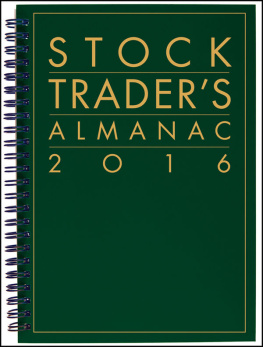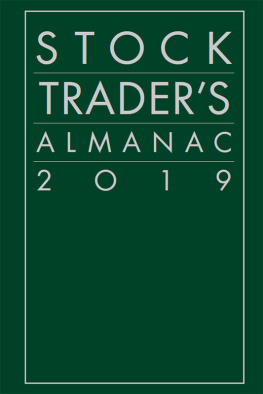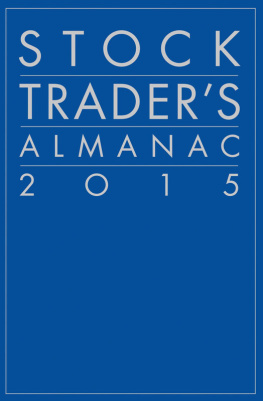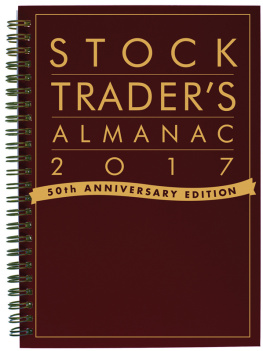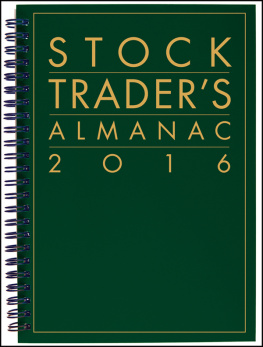Copyright 2016 by John Wiley & Sons, Inc. All rights reserved.
Published by John Wiley & Sons, Inc., Hoboken, New Jersey.
| Editor in Chief | Jeffrey A. Hirsch |
| Editor at Large | Yale Hirsch |
| Director of Research | Christopher Mistal |
| Production Editor | Steven Kyritz |
No part of this publication may be reproduced, stored in a retrieval system, or transmitted in any form or by any means, electronic, mechanical, photocopying, recording, scanning, or otherwise, except as permitted under Section 107 or 108 of the 1976 United States Copyright Act, without either the prior written permission of the Publisher, or authorization through payment of the appropriate per-copy fee to the Copyright Clearance Center, 222 Rosewood Drive, Danvers, MA 01923, 978-750-8400, fax 978-646-8600, or on the web at www.copyright.com. Requests to the Publisher for permission should be addressed to the Permissions Department, John Wiley & Sons, Inc., 111 River Street, Hoboken, NJ 07030, 201-748-6011, fax 201-748-6008, or online at www.wiley.com/go/permissions.
Limit of Liability/Disclaimer of Warranty: While the publisher and the author have used their best efforts in preparing this book, they make no representations or warranties with respect to the accuracy or completeness of the contents of this book and specifically disclaim any implied warranties of merchantability or fitness for a particular purpose. No warranty may be created or extended by sales representatives or written sales materials. The advice and strategies contained herein may not be suitable for your situation. You should consult with a professional where appropriate. Neither the publisher nor the author shall be liable for any loss of profit or any other commercial damages, including but not limited to special, incidental, consequential, or other damages.
For general information about our other products and services, please contact our Customer Care Department within the United States at 800-762-2974, outside the United States at 317-572-3993, or fax at 317-572-4002.
Wiley publishes in a variety of print and electronic formats and by print-on-demand. Some material included with standard print versions of this book may not be included in e-books or in print-on-demand. If this book refers to media such as a CD or DVD that is not included in the version you purchased, you may download this material at http://booksupport.wiley.com. For more information about Wiley products, visit our website at www.wiley.com.
| ISBN: 978-1-119-11068-2 (paper) |
| ISBN: 978-1-119-18933-6 (ebk) |
| ISBN: 978-1-119-18930-5 (ebk) |
This Forty-Ninth Edition is respectfully dedicated to:
Sy L. Harding (1935-2015)
and
Michael L. Burke (1935-2014)
Since the last edition, we have lost these two legends of Wall Street. We were privileged to know both gentlemen and continue to benefit immeasurably from their work. Renowned fundamental and technical analysis, award winning market timing, prolific market research, and distinguished investment newsletters; Sy and Mike will be deeply missed.
Mike was Editor of Chartcraft publications and Investors Intelligence from 1982 to 1999 and co-editor with John Gray 20002014. He taught fundamental and technical analysis at the New School, New York from 19781990 and was a columnist and contributing editor of the Moneypaper from 19832012. He authored The Three Box Reversal Method of Point and Figure: Construction and Formations (Chartcraft) in 1999. Mike developed Point and Figure Relative Strength analysis for stocks. He created the Broad Industry Group Bullish %'s technique for finding depressed stock market sectors about to rally and the industry group Insider Analysis as a leading indicator of what senior corporate executives think about the next moves in their companies' share price. He inaugurated a number of different model portfolios, including the Fidelity Switch Fund concentrating on equities, Fidelity bond and international funds, and three portfolios of individual stocks: Low-Priced, Long-Term, and Income & Appreciation. To this day, we continue to incorporate Investors Intelligence research and indicators into our market analysis.
Sy was a true man of all seasons. He was one of the foremost proponents of market seasonality, cycles, and recurring historical patterns, so naturally we were keen on each other's research, analysis, strategies, and systems. Sy enhanced our Best Six Months Switching Strategy (pages 52, 54, 60 and 62) with MACD triggers, dubbing it the best mechanical system ever. He founded Asset Management Research Corp in 1988 and published the Street Smart Report, providing research, analysis, and timing on the stock, gold, and bond markets. With a background in engineering as founder and owner of two high-tech manufacturing firms, it was natural that his research involved technical analysis and charting as well as fundamentals. Sy was frequently ranked in the Top Ten Market Timers in the U.S. He authored the 1999 book Riding the Bear: How to Prosper in the Coming Bear Market (Adams Media), which accurately predicted the 20002002 bear market, and How to Beat the Market the Easy Way! (Wheatmark) in 2007, just prior to the 20072009 bear market, which introduced market-timing strategies for down markets.
CONTENTS
Guide
Pages
INTRODUCTION TO THE FORTY-NINTH EDITION
We are pleased and proud to introduce the Forty-Ninth Edition of the Stock Trader's Almanac. The Almanac provides you with the necessary tools to invest successfully in the twenty-first century.
J. P. Morgan's classic retort, Stocks will fluctuate, is often quoted with a wink-of-the-eye implication that the only prediction one can make about the stock market is that it will go up, down, or sideways. Many investors agree that no one ever really knows which way the market will move. Nothing could be further from the truth.
We discovered that while stocks do indeed fluctuate, they do so in well-defined, often predictable patterns. These patterns recur too frequently to be the result of chance or coincidence. How else do we explain that since 1950 all the gains in the market were made during November through April, compared to a loss May through October? (See page 52.)
The Almanac is a practical investment tool. It alerts you to those little-known market patterns and tendencies on which shrewd professionals enhance profit potential. You will be able to forecast market trends with accuracy and confidence when you use the Almanac to help you understand:
- How our presidential elections affect the economy and the stock marketjust as the moon affects the tides. Many investors have made fortunes following the political cycle. You can be sure that money managers who control billions of dollars are also political cycle watchers. Astute people do not ignore a pattern that has been working effectively throughout most of our economic history.
- How the passage of the Twentieth Amendment to the Constitution fathered the January Barometer. This barometer has an outstanding record for predicting the general course of the stock market each year, with only eight major errors since 1950, for an 87.7% accuracy ratio. (See page 16.)
- Why there is a significant market bias at certain times of the day, week, month, and year.
Even if you are an investor who pays scant attention to cycles, indicators, and patterns, your investment survival could hinge on your interpretation of one of the recurring patterns found within these pages. One of the most intriguing and important patterns is the symbiotic relationship between Washington and Wall Street. Aside from the potential profitability in seasonal patterns, there's the pure joy of seeing the market very often do just what you expected.

